(VOVWORLD) - Lion dancing is a typical art form in a number of East Asian countries, including Vietnam. Lion dancing is usually performed during festivals and special occasions, particularly during the Lunar New Year (or Tet) festival. It is believed that unicorns, lions, and dragons symbolize happiness and prosperity, as well as heralding good luck in the new year.
Hai Nam Lien Huu lion dance troupe has existed for more than 60 years in district 5, Ho Chi Minh city - and is the oldest one in Sai Gon-Cho Lon, the city’s Chinatown. Lam Dan, the head of Hai Nam Lien Huu lion dance troupe, said, “Hai Nam Lien Huu lion dance troupe was founded in 1953. The founder of the troupe was Su Xuong Can, who then handed it over to my father, Lam Dao Hung. We have performed at lots of events and contests and won many national and international prizes.”
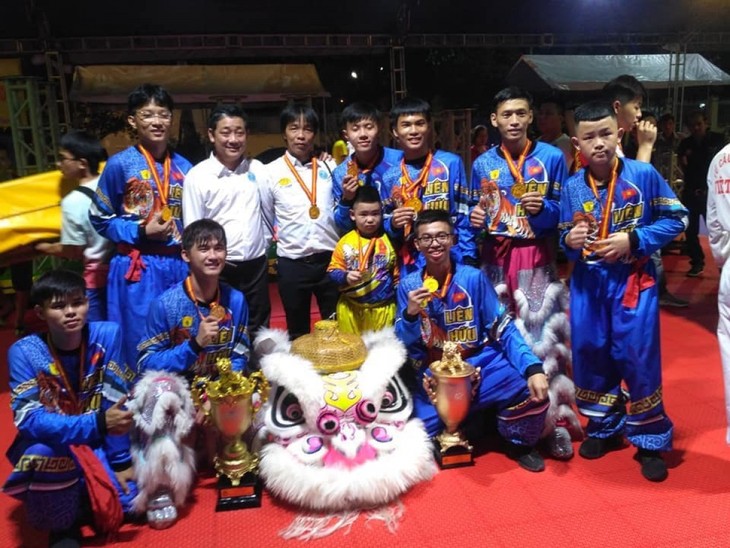 Lam Dan (standing, third from left), head of Hai Nam Lien Huu lion dance troupe, and other members at a lion dance competition. (Photo credit: Hai Nam Lien Huu) Lam Dan (standing, third from left), head of Hai Nam Lien Huu lion dance troupe, and other members at a lion dance competition. (Photo credit: Hai Nam Lien Huu) |
Lion dancing is an art form, with each move requiring skillful and meticulous techniques from the artists. The performers need to have a great passion for their art, and must undergo a strict training regime for many years to be able to perform.
In Vietnam, lion dancing combines martial arts with folk dancing. The performers must wear a lion costume, mimic the animal’s movements, and put their soul into the dance. Successful dancers bring great joy to the audience.
“You must practise a lot to perform the lion dance well. In the past, a lion dancer practiced martial arts first to have good posture and flexibility, which enabled them to perform more skillfully,” said Lam Dan.
A lion dance troupe normally has dozens, to hundreds, of members who are divided into different teams, specializing in certain performances for different occasions. It can take a dancer many days to master a basic movement. A performer must understand the drum sounds, and knows how to coordinate with their teammates in harmony.
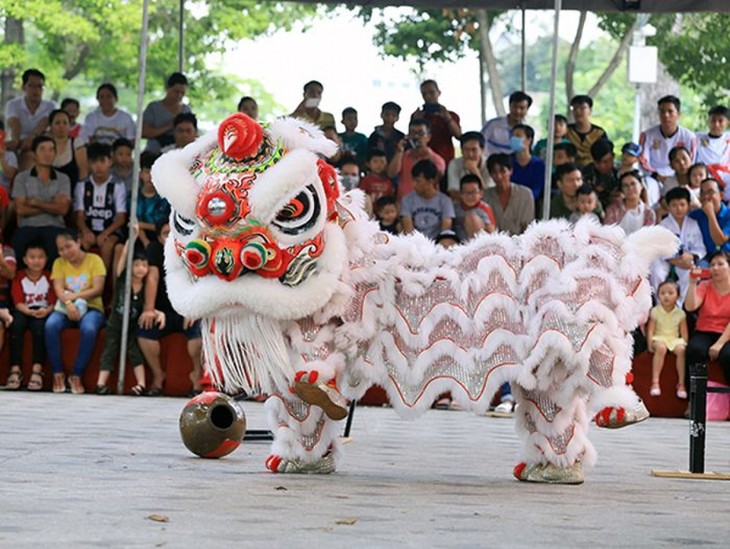 Two people will control the head and the tail of the lion. (Photo credit: Hai Nam Lien Huu). Two people will control the head and the tail of the lion. (Photo credit: Hai Nam Lien Huu). |
Luong Kien Toan, born in 1996, is the grandchild of the Hai Nam Lien Huu lion dance troup’s founder. Toan said a lion dance performance requires 6 people.
“Two people will control the head and the tail of the lion. The other four are in charge of drums and musical instruments. All the performers must practise hard, so that the movements match the rhythm. The person who is in the lion tail must have strong feet and stand firmly, so the others can climb on him to create a standing pose. The person in the upper part needs to be more flexible. Both the head and the tail sections need to coordinate perfectly,” Toan explained.
Lion dancing is not only performed on the ground, but also on stilts. This is much more difficult as dancers have to perform at great heights in big lion costumes. If two performers fail to coordinate with each other, they will fall. Dancers are often injured while performing lion dances.
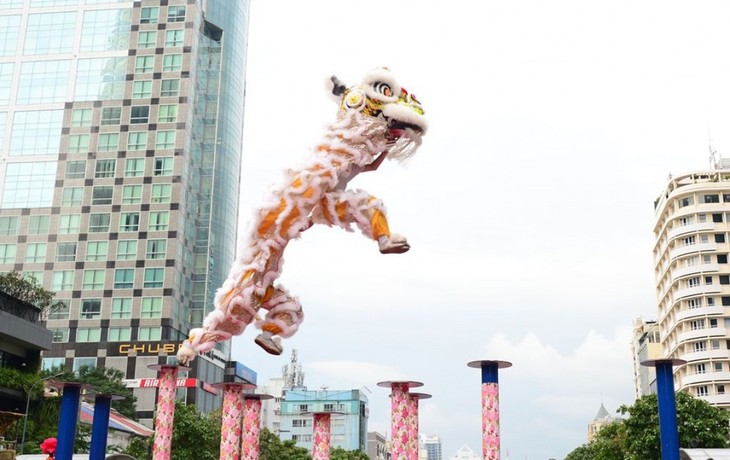 Lion dancing is not only performed on the ground, but also on stilts. Lion dancing is not only performed on the ground, but also on stilts. |
According to the cultural beliefs of Vietnam, and several other East Asian countries, a family or business visited by a lion dance performance will have good luck. The lion costume is meant to blend different elements of sacred animals together. It has the teeth of a dragon, the nose of a unicorn, the eyes of a phoenix, and the tail of a tortoise. Its mouth has thorns, which look like a fish’s fins, as the koi carp represents success and promotion.
Lions or unicorns dancing with plantinum or golden whiskers represent prosperity and luck, so are often seen performing at the opening ceremony for new businesses. The beginning and end of the lunar year are the busiest times for lion dance troupes. Dang Tran Tinh, who has been a member of Hai Nam Lien Huu lion dance troupe for more than 15 years, said, “We perform in many places during the Lunar New Year holiday. We also perform on other occasions such as inauguration ceremonies, and the Mid-autumn Festival.”
The sound of drummers accompanying lion dances are heard throughout Lunar New Year festival, which is expected to bring luck, prosperity and success in the new year.
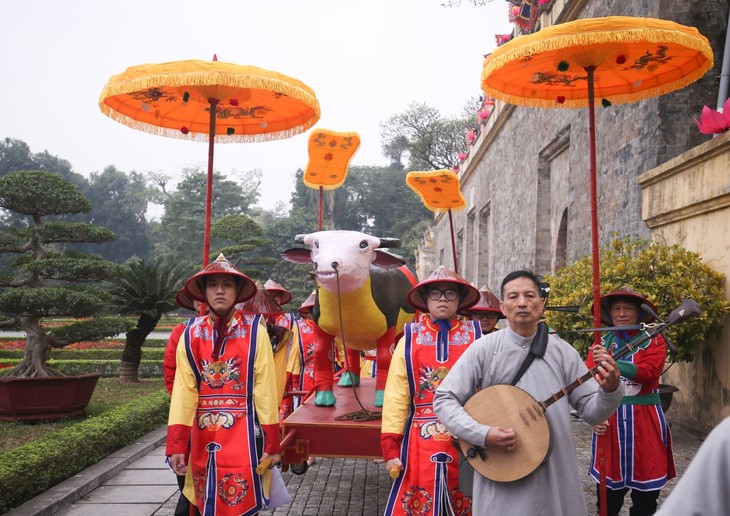 “Tien Xuan Nguu” is a unique ritual of Vietnam’s royal court. “Tien Xuan Nguu” is a unique ritual of Vietnam’s royal court. |
Tet, or the Lunar New Year, is the time for festivals and rituals. The ceremony of offering the king a life-sized, clay buffalo in spring called “Tien Xuan Nguu” was a unique ritual of Vietnam’s royal court. It has been re-enacted for the first time at the Thang Long Imperial Citadel in Hanoi to mark the Year of the Buffalo.
“Tien Xuan Nguu” was a form of worship during the Le dynasty from the 16th to the 18th centuries. The ritual was held on the day when spring begins under the watchful eye of the King, as well as civil and military mandarins.
The buffalo also represents the month of December, and so are associated with the last month of winter of the passing year. Using a strawberry whip to hit the buffalo's hind symbolises “expelling the cold of the previous winter, whilst welcoming the New Year, a warm spring, and bountiful harvests”.
“The Vietnamese have a proverb that having a water buffalo allows one to start a business, which stresses the importance of the buffalo to Vietnam’s wet rice cultivation. A buffalo represents the rural workforce, and signals increased yield. The ritual “Tien Xuan Nguu” represents the expulsion of the cold winter and the start of a new crop,” said Mr. Vo Van Hai, director of the “Tien Xuan Nguu” re-enactment.
The ceremony includes a buffalo parade, offering the buffalo to the King, presenting gifts to mandarins, and the whipping of the buffalo.
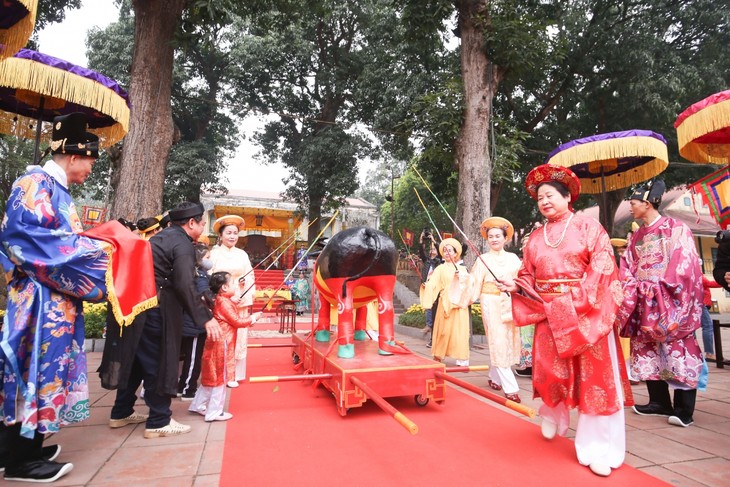 The ritual of using a strawberry whip to hit the buffalo's hind during the reenactment of "Tien Xuan Nguu". The ritual of using a strawberry whip to hit the buffalo's hind during the reenactment of "Tien Xuan Nguu". |
During the ceremony, the mandarins, according to their ranks, were assigned to stand on the east and west sides of the Dragon Court while the King sat on the throne in the center of the Kinh Thien Palace.
The buffalo procession stopped at the Dong Hoa gate of the Imperial City. Only the chief of the city and his soldiers were then allowed to enter the Forbidden Palace to offer the giant Buffalo idol to the king. After that, the mandarins performed the ritual of "whipping the buffalo" to welcome the Spring.
The "Tien Xuan Nguu" ceremony ended with the mandarin of the Treasury accepting the large Buffalo God, as well as 1,215 calves. The minature calves, made from wood or clay, were presented on red wooden trays and covered with yellow silk cloths. These young buffaloes were presented by the king to the high-ranking dignitaries first, then the rest were usually distributed to the other mandarines and their wives in Thang Long Imperial Citadel.
“Though it is a symbolic ritual, it still features all the steps and members who took part in the original royal ceremony. In the upper palace is the King. There are mandarins of all ranks standing on both sides. Some bureaucrats played a special role. One mandarin connected the King with other participants. One mandarin led the ceremony. Another mandarin supervised the offering of the buffalo, and presented gifts to other officials,” said Master Pham Vu Loc from the Vietnam Academy of Social Sciences.
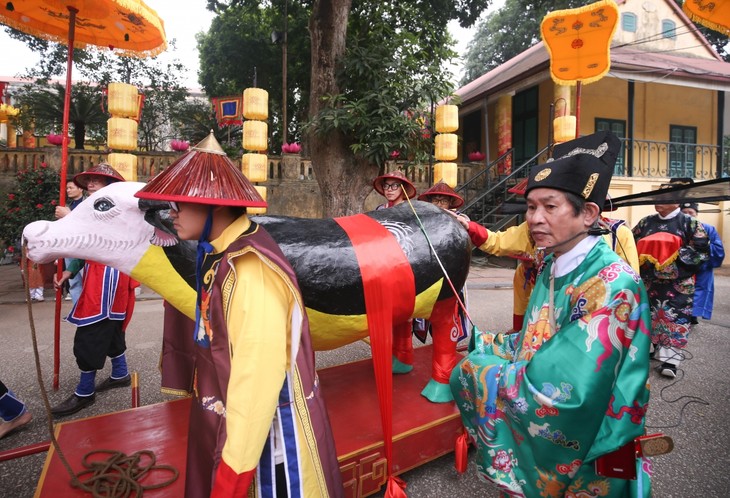 The buffalo is a symbol of wet rice cultivation. The buffalo is a symbol of wet rice cultivation. |
“After the Le Dynasty, the royal court was moved to the imperial city of Hue during the Nguyen Dynasty. The ritual 'Tien Xuan Nguu' fell into obscurity for a long time during the war, and Vietnam’s subsequent modernistation. I am so happy to see the ritual reenacted, and hope that the ceremony will continue to be held from the next Lunar New Year,” said journalist Ngo Vuong Anh who attended the ritual.
Mr. Pham Vu Loc said many folk rituals and historic festivals have been studied, but not many of the royal rituals have been successfully re-enacted. The ritual “Tien xuan nguu” was studied intensively, in order to preserve the authentic traditional culture of the Thang Long Citadel, and the Vietnamese nation.
“There are many royal rituals relating to agriculture and spring such as the Tich Dien New Year plowing festival, but this is the first time the ritual 'Tien Xuan Nguu' has been reenacted," said Mr. Loc.
"The re-enactment of the ritual closely reflects the original one with traditional customs, and royal costumes, which helps bring history to life. We hope that the restoration of such rituals will make people more aware of preserving Vietnam’s traditional cultural values.”